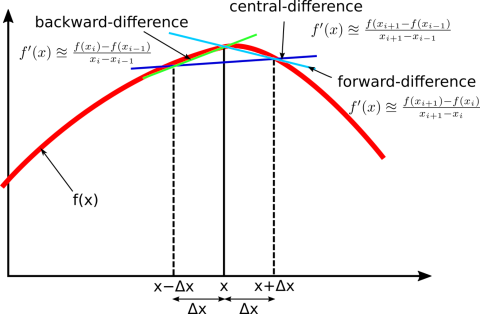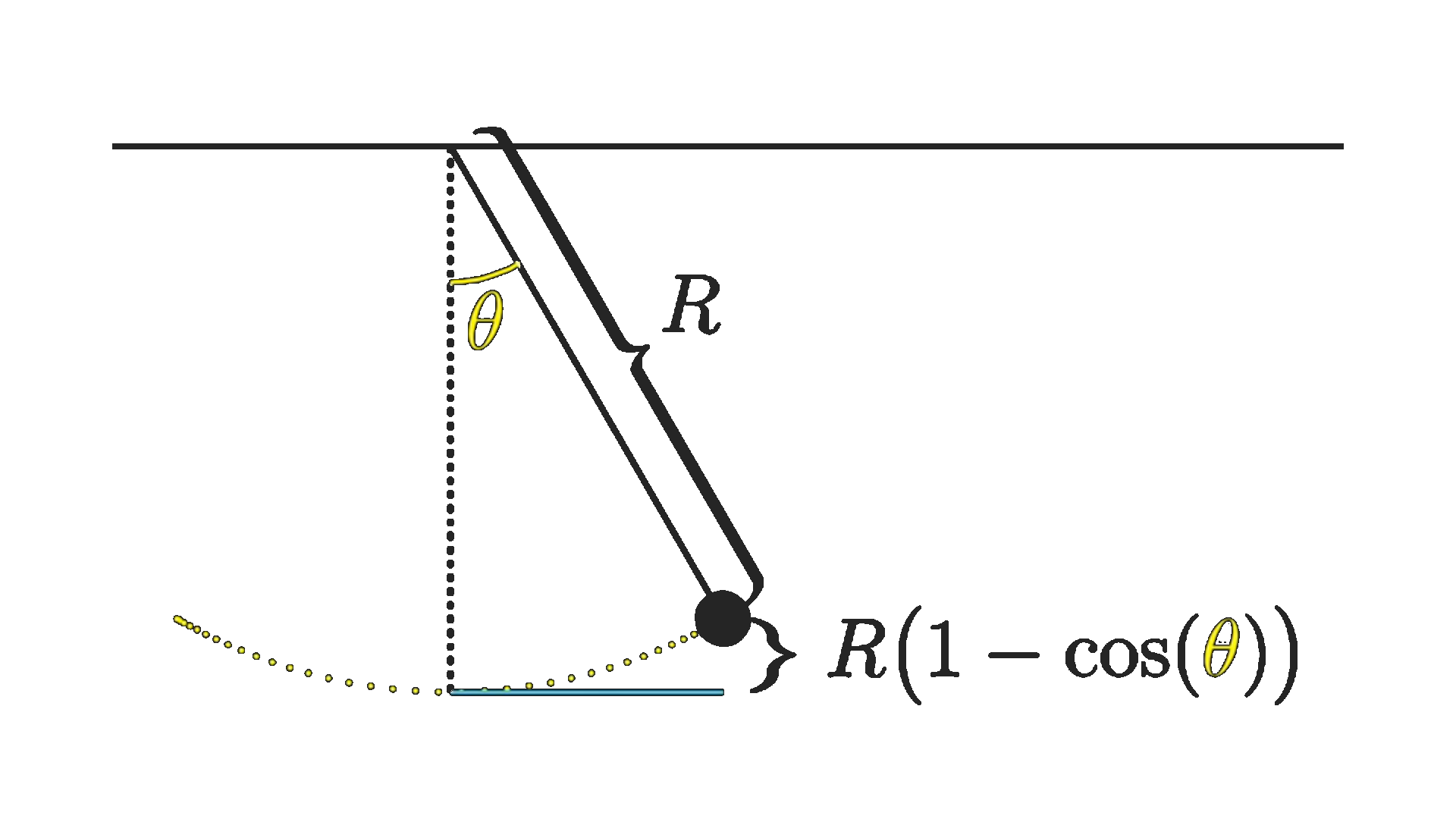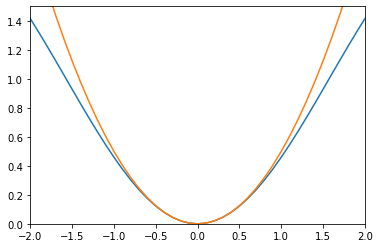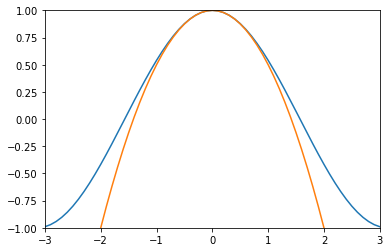Lecture 05: Numerical differentiation#
Objectives:#
explain the definitions of forward, backward, and center divided methods for numerical differentiation
find approximate values of the first derivative of continuous functions
reason about the accuracy of the numbers
find approximate values of the first derivative of discrete functions (given at discrete data points)
Numerical differentiation is the process of finding the numerical value of a derivative of a given function at a given point.
A simple two-point estimation is to compute the slope of a nearby secant line through the points \((x, f(x))\) and \((x + h, f(x + h))\). Choosing a small number \(h\), \(h\) represents a small change in \(x\) (\(h <<1\) and is positive). The slope of this line is

Three basic types are commonly considered: forward, backward, and central differences.

Forward difference#
import math
def forward_diff(f, x, h=1e-4):
dfx = (f(x+h) - f(x))/h
return dfx
x = 0.5
df = forward_diff(math.cos, x)
print ("first derivative of cos(x) is {}, which is -sin(x) {}".format(df, -math.sin(x)))
print("O(h) is ", (df + math.sin(x)))
first derivative of cos(x) is -0.4794694169341085, which is -sin(x) -0.479425538604203
O(h) is -4.387832990548901e-05
Backward difference#
import math
def backward_diff(f, x, h=1e-4):
dfx = (f(x) - f(x-h))/h
return dfx
x = 0.5
df = backward_diff(math.cos, x)
print ("first derivative of cos(x) is {}, which is -sin(x) {}".format(df, -math.sin(x)))
print("O(h) is ", (df + math.sin(x)))
first derivative of cos(x) is -0.47938165867678073, which is -sin(x) -0.479425538604203
O(h) is 4.3879927422274534e-05
Central difference method#
import math
def central_diff(f, x, h=1e-4):
dfx = (f(x+h) - f(x-h))/(2*h)
return dfx
x = 0.5
df = central_diff(math.cos, x)
print ("first derivative of cos(x) is {}, which is -sin(x) {}".format(df, -math.sin(x)))
print("O(h^2) is ", (df + math.sin(x)))
first derivative of cos(x) is -0.4794255378054446, which is -sin(x) -0.479425538604203
O(h^2) is 7.98758392761556e-10
Second derivative#
import math
def central_second_diff(f, x, h=1e-4):
dfx = (f(x+h) -2*f(x) + f(x-h))/(h**2)
return dfx
x = 0.5
df = central_second_diff(math.cos, x)
print ("second derivative of cos(x) is {}, which is -cos(x) {}".format(df, -math.cos(x)))
print("O(h^2) is ", (df + math.sin(x)))
second derivative of cos(x) is -0.8775825732776354, which is -cos(x) -0.8775825618903728
O(h^2) is -0.39815703467343244
Scipy differentiate#
Another library, which largely builds on NumPy and provides additional functionality, is SciPy (https://www.scipy.org/). SciPy provides some more specialised data structures and functions over NumPy. If you are familiar with MATLAB, NumPy and SciPy provide much of what is available in MATLAB.
from scipy.misc import derivative
scipy.misc.derivative(func, x0, dx=1.0, n=1, args=(), order=3)[source]
from scipy.misc import derivative
def f(x):
return x**3 + x**2
derivative(math.cos, .5, dx=1e-6, n=2)
-0.8777423232686488
Taylor series and approximations#
Taylor series is one the best tools maths has to offer for approximating functions. Taylor series is about taking non-polynomial functions and finding polyomials that approximate at some input. The motive here is the polynomials tend to be much easier to deal with than other functions, they are easier to compute, take derivatives, integrate, just easier overall.
Taylor series of a function is an infinite sum of terms that are expressed in terms of the function’s derivatives at a single point. The Taylor series of a function \(f(x)\) that is infinitely differentiable at a real or complex number \(a\) is the power series
Potential energy of a simple pendulum#
To determine the potential energy of a pendulum, for that we need an expression for how high the weight of the pendulum is above its lowest point. This works out to be \(h = R(1 - \cos(\theta))\) The cosine function made the problem awkward and unweildy. But, if we approximate the \(\cos(\theta) \approx 1 + \frac{\theta^2}{2}\) of all things, everything just fell into place much more easily.
Taylor series approximation \(\cos(\theta) \approx \) for a parabola, a hyperbolic function like \(\cosh(x)\approx 1 + \frac{x^2}{2}\), which gives \(h = R(1 - (1 + \frac{\theta^2}{2})) = R \frac{\theta^2}{2}\)
An approximation like that might seem completely out of left field. If we graph these functions, they do look close to each other for small angles.

import matplotlib.pyplot as plt
import math
import numpy as np
x = np.arange(-3,3.1,0.1) # start,stop,step
r = 1
y = r * (1 - np.cos(x))
z = [i**2/2 for i in x]
plt.plot(x, y)
plt.plot(x, z)
plt.xlim([-2, 2])
plt.ylim([0,1.5])
(0.0, 1.5)

Approx cos Taylor series#
import matplotlib.pyplot as plt
import math
import numpy as np
x = np.arange(-9,9.1,0.1) # start,stop,step
y = np.cos(x)
plt.plot(x, y)
def cos_approx(x, n = 4):
cos = 1
j = -1
for i in np.arange(2, n, 2):
cos += x**i * j / math.factorial(i)
j = j * -1
return cos
#return 1 - x**2/2 + x**4/math.factorial(4)
z = [cos_approx(i, n=4) for i in x]
plt.plot(x, z)
plt.xlim([-3, 3])
plt.ylim([-1, 1])
(-1.0, 1.0)

Newton Raphson#
The Newton-Raphson method (also known as Newton’s method) is a way to quickly find a good approximation for the root of a real-valued function \(f(x)=0\). It uses the idea that a continuous and differentiable function can be approximated by a straight line tangent to it. Suppose you need to find the root of a continuous, differentiable function f(x)f(x)f(x), and you know the root you are looking for is near the point \(x = x_0\). Then Newton’s method tells us that a better approximation for the root is
This process may be repeated as many times as necessary to get the desired accuracy. In general, for any \(x-\)value \(x_n\), the next value is given by
# The function is x^3 - x^2 + 2
def fn(x):
return x**3 - x**2 + 2
# Derivative of the above function
# which is 3*x^x - 2*x
def dfn(x):
return 3 * x**2 - 2 * x
# Function to find the root
def newton_raphson(x):
for i in range(1000):
h = fn(x) / dfn(x)
# x(i+1) = x(i) - f(x) / f'(x)
x = x - h
if abs(h) < 0.0001:
return x
#
x0 = -20 # Initial values assumed
print("The root of fn: {}".format(newton_raphson(x0)))
The root of fn: -1.000000000000011
Generic Newton Raphson method#
import math
import numpy as np
from scipy.misc import derivative
# Define fn(x)
def f0(x):
return x**3 - x**2 + 2
# Derivative of dfn(x)
def df0(x):
return 3 * x**2 - 2*x
# Central difference first derivative
def central_difference(fn, x, h = 1e-6):
dfx = (fn(x+h) - fn(x-h))/(2*h)
return dfx
def newton_raphson(x, fn, max_iter=100, tol=1e-6):
"""Newton - Raphson for solving roots of a polynomial"""
for i in np.arange(max_iter):
df = derivative(fn, x, dx=1e-6)
h = fn(x) / df
# x_{n+1} = x_{n} - fn(x_n)/f'(x_n)
x = x - h
if abs(h) < tol:
break
else: #no break
print("The NR did NOT converge")
return x, i, abs(h)
# Initial guess
x0 = -2
x, iter, err = newton_raphson(x0, f0, 30, 1e-5)
print("The solution to fn(x) is {} after {} iterations with an error of {}".format(x, iter, err))
The solution to fn(x) is -1.0 after 5 iterations with an error of 2.3237767257574307e-10
Advantages and Disadvantages:#
The method is very expensive - It needs the function evaluation and then the derivative evaluation.
If the tangent is parallel or nearly parallel to the x-axis, then the method does not converge.
Usually Newton method is expected to converge only near the solution.
The advantage of the method is its order of convergence is quadratic.
Convergence rate is one of the fastest when it does converges
